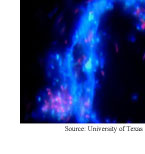|
NEWS
|
Pond scum ethanol
 A blue-green algae that's genetically modified
to include genes from a cellulose-producing bacteria promises
to turn pond scum into an efficient, inexpensive source
of feedstock for producing ethanol. The algae lives on
sunlight, and the cellulose it produces is more easily
converted to ethanol than the cellulose from plant matter.
(Transgenic
Expression of Gluconacetobacter Xylinus Strain ATCC 53582
Cellulose Synthase Genes in the Cyanobacterium Synechococcus
Leopoliensis Strain UTCC, Cellulose, published
online April 12, 2008)
A blue-green algae that's genetically modified
to include genes from a cellulose-producing bacteria promises
to turn pond scum into an efficient, inexpensive source
of feedstock for producing ethanol. The algae lives on
sunlight, and the cellulose it produces is more easily
converted to ethanol than the cellulose from plant matter.
(Transgenic
Expression of Gluconacetobacter Xylinus Strain ATCC 53582
Cellulose Synthase Genes in the Cyanobacterium Synechococcus
Leopoliensis Strain UTCC, Cellulose, published
online April 12, 2008)
Off-the-shelf nanoparticles
A library of more than 1,200 nanoparticles opens
the way for researchers to select particles for delivering
drugs, matching particle properties to drug and target
disease rather than building a nanoparticle from scratch.
Some of the library's nanoparticles are well suited for
delivering the small pieces of RNA used to turn off specific
genes in RNA interference, a new technique that shows
promise for treating cancer and other diseases. (A
Combinatorial Library of Lipid-like Materials for Delivery
of RNAi Therapeutics, Nature Biotechnology,
published online April 27, 2008)
Quartz keeps nanotubes in line
A recipe for growing single-walled carbon nanotubes
on quartz surfaces yields relatively dense arrays of long,
parallel nanotubes. The technique could lead to ways of
mass producing carbon nanotube arrays for building new
types of computer chips and other electronics. (Growth
of High-Density Parallel Arrays of Long Single-Walled
Carbon Nanotubes on Quartz Substrates, Journal
of the American Chemical Society, April 23, 2008)
More accurate ions
A prototype quantum computer made from a pair
of trapped ions achieves a fidelity of 99.3 percent for
logic operations involving entangling the two quantum
bits. The performance is a key step toward reaching the
99.99 percent fidelity required for practical quantum
computing. Quantum computers promise to be much faster
than ordinary computers for certain tasks like cracking
secret codes. (Towards
Fault-tolerant Quantum Computing with Trapped Ions,
Nature Physics, published online April 27, 2008)
Opaque ghosts
The technique of taking pictures by pointing a
digital camera at the light source shining on an object
rather than the object itself, dubbed ghost imaging, extends
to opaque objects. The method works by splitting a weak
beam of light and using a photon counter to detect photons
bouncing off of the object. Photons that are paired get
split, with one of the pair going to the camera and the
other the object. The detector signals the camera to record
only photons that hit at that moment. The positions of
the recorded photons correspond to the positions of photons
that hit the object, allowing an image to form. Ghost
imaging could lead to new forms of x-ray imaging. (Ghost-Imaging
Experiment by Measuring Reflected Photons, Physical
Review A, April 2008)
Lighting virtual fog
Virtual heavy metal bands, rejoice! A more efficient
version of software that accurately simulates light shining
in fog, smoke and clouds means that realistic special
effects could be more widely available for use in movies
and video games. The technique makes it easier to calculate
some aspects of traditionally computer-intensive ray tracing
software. (The
Beam Radiance Estimate for Volumetric Photon Mapping,
Eurographics 2008, Hersonissos, Crete, Greece, April 14-18,
2008) |
FEATURES
|
View
from the High Ground
Email conversations with researchers in
high places.
|
How
It Works
Get the nitty-gritty on nanotechnology, biochips, self-assembly,
DNA technologies, quantum cryptography, and more. |
|
 |
News RSS feed 
Blog RSS feed 
|
| |
|
| |
"Physics
is to the rest of science what machine tools are
to engineering. A corollary is that science places
power in our hands which can be used for good or
ill. Technology has been abused in this way throughout
the ages from gunpowder to atomic bombs."
- John Pendry, Imperial College London |
|
| |
|
| |
Thanks
to Kevin from
GoldBamboo.com
for technical support |
|

